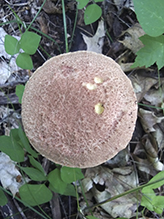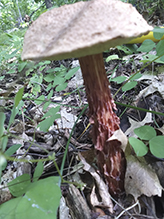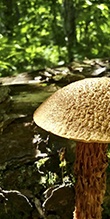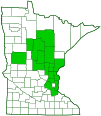Russell’s Bolete
(Aureoboletus russellii)
Conservation • Description • Habitat • Ecology • Distribution • Taxonomy
Conservation Status |
|
|||||||
| IUCN Red List | not listed |
|||||||
| NatureServe | NNR - Unranked |
|||||||
| Minnesota | not listed |
|||||||
Description |
||
Russell’s Bolete is a fairly common, medium-sized to large, fleshy mushroom. It occurs in the United States east of the Great Plains. There is a disjunct population in southeastern Arizona, an area that hosts a number of eastern species. It also occurs in southern Mexico, northern Central America, and Japan. It is found in the summer and early fall, alone, scattered, or in small groups. It grows on the ground usually under oaks but also under other deciduous trees and sometimes under coniferous trees. It has a mutually beneficial relationship (mycorrhizal) with the tiny rootlets of trees, absorbing sugars and amino acids while helping the tree absorb water. When it first appears the cap is convex, the margins are rolled inward, and the upper surface is densely covered with fine velvety hairs. It can be yellowish-brown, reddish-brown, buff, or olive-gray. As it ages the cap spreads out and becomes hairless (bald). Mature caps are broadly convex. They can be 1¼″ to 5″ (3 to 13 cm) in diameter but are usually no more than 3½″ (9 cm) in diameter. The upper surface breaks up into small scales exposing the pale flesh beneath. The stalk is solid, tough, reddish-brown, slender, 4″ to 8″ (10 to 20 cm) long, and 5⁄16″ to ¾″ (8 to 20 mm) thick. It is dry but when young it is sticky just at the base. It is often curved, and it is usually the same size for its entire length, but sometimes it is slightly thickened at the base. The surface is deeply ridged and pocketed (lacerated) in a net-like pattern (reticulate). The pore surface is yellow when young, becoming greenish-yellow with age. It does not change color when bruised. The pores are angular and wide, 1⁄32″ (1 mm) broad or more. The pore tubes are up to ⅝″ (15 mm) deep. The flesh is pale yellow throughout, including under the upper skin (cuticle). It does not change color when bruised or sliced. It is edible but the texture is soft and the taste is bland. The spore print is dark olive to olive brown. |
||
Similar Species |
||
Habitat and Hosts |
||
Oaks and other deciduous trees, sometimes coniferous trees |
||
Ecology |
||
Season |
||
Summer and early fall |
||
Distribution |
||||
|
Sources |
|||
| 11/4/2022 | ||||
Occurrence |
||||
Fairly common |
||||
Taxonomy |
|||
| Kingdom | Fungi (Fungi) | ||
| Subkingdom | Dikarya | ||
| Phylum | Basidiomycota (Basidiomycete Fungi) | ||
| Subphylum | Agaricomycotina (Higher Basidiomycetes) | ||
| Class | Agaricomycetes (Mushrooms, Bracket Fungi, Puffballs, and Allies) | ||
| Subclass | Agaricomycetidae | ||
| Order | Boletales (boletes and allies) | ||
| Suborder | Boletineae | ||
Family |
Boletaceae (boletes) | ||
| Subfamily | Xerocomoideae | ||
Genus |
Aureoboletus | ||
This species was originally described in 1878 as Boletus russellii. In 1931 it was moved to the genus Boletellus, and in 2016 it was moved to the genus Aureoboletus. |
|||
Synonyms |
|||
Boletus russellii Boletellus russellii Boletogaster russellii Ceriomyces russellii Frostiella russellii Suillus russellii |
|||
Common Names |
|||
Jagged-stemmed Bolete Pitted Bolete Russell’s Bolete Shagnet |
|||
Glossary
Mycorrhizal
A symbiotic, usually beneficial relationship between a fungus and the tiny rootlets of a plant, usually a tree.
Visitor Photos |
|||||
Share your photo of this fungus. |
|||||
| This button not working for you? Simply email us at info@MinnesotaSeasons.com. Attach one or more photos and, if you like, a caption. |
|||||
Luciearl |
|||||
 |
 |
||||
Found many Russell's bolete in the woods today. |
|||||
 |
|||||
MinnesotaSeasons.com Photos |
|||||
|
|||||

Slideshows |
||

Visitor Videos |
|||
Share your video of this fungus. |
|||
| This button not working for you? Simply email us at info@MinnesotaSeasons.com. Attach a video, a YouTube link, or a cloud storage link. |
|||
Other Videos |
|||
| Bolete Russell's mushroom BOLD STROKE ADVENTURES |
|||
About
Aug 25, 2019 Boletellus russellii, commonly known as Russell's bolete, is a species of bolete fungusin the family Boletaceae. An edible species, it is found in Asia and eastern North America, where it grows in a mycorrhizal association with oak, hemlock, and pine trees. Fruit bodiesof the fungus are characterized by their coarsely shaggy stem. The yellow-brown to reddish-brown caps are initially velvety, but become cracked into patches with age. |
|||

Visitor Sightings |
|||||
Report a sighting of this fungus. |
|||||
| This button not working for you? Simply email us at info@MinnesotaSeasons.com. Be sure to include a location. |
|||||
| Luciearl 8/15/2023 |
Location: Fairview Twp Found many Russell's bolete in the woods today. |
||||
| Luciearl 8/30/2022 |
Location: Fairview Twp, Cass County |
||||
MinnesotaSeasons.com Sightings |
|||||
|
|||||

Created: 11/4/2022
Last Updated:


